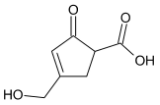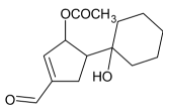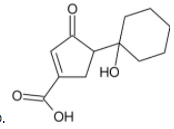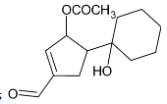
The major product formed in the given reaction is?

A)

B)

C)

D)






Answer
537.9k+ views
Hint:
To answer this question, you must recall the action of pyridinium chlorochromate (PCC). PCC oxidises alcohols but not aldehydes or ketones.
Complete step by step solution:
PCC (Pyridinium chlorochromate) is a milder version of chromic acid which too is used as an oxidising agent. PCC oxidizes alcohols one step up the oxidation ladder to carbonyl compounds.
By the action of PCC, primary alcohols are converted into aldehydes and secondary alcohols are converted into ketones.
While chromic acid oxidizes aldehydes further to form carboxylic acids, PCC being a milder oxidising agent does not.
In the given problem, there are two alcohol groups present in the reactant. One is a primary alcohol group while the other is tertiary.
Tertiary alcohols are difficult to oxidise and their oxidation causes the breaking of a bond and removal of at-least one substituent group present on the tertiary carbon atom. Pyridinium chlorochromate is a mild oxidising agent and cannot carry out the oxidation of tertiary alcohols.
The primary alcohol group is however oxidised to form aldehyde.
Thus, we can conclude that the product formed is

The correct option is C.
Note:
Oxidation reactions like these can be seen as a kind of elimination reaction. The carbon oxygen single bond in the alcohol is converted to a carbon oxygen double bond while hydrogen atoms are lost from both the carbon and oxygen. The elimination reaction is possible because of the presence of a good leaving group on the oxygen during the transition state, namely the chromium ion, which is eliminated when the neighbouring carbon hydrogen bond is broken.
To answer this question, you must recall the action of pyridinium chlorochromate (PCC). PCC oxidises alcohols but not aldehydes or ketones.
Complete step by step solution:
PCC (Pyridinium chlorochromate) is a milder version of chromic acid which too is used as an oxidising agent. PCC oxidizes alcohols one step up the oxidation ladder to carbonyl compounds.
By the action of PCC, primary alcohols are converted into aldehydes and secondary alcohols are converted into ketones.
While chromic acid oxidizes aldehydes further to form carboxylic acids, PCC being a milder oxidising agent does not.
In the given problem, there are two alcohol groups present in the reactant. One is a primary alcohol group while the other is tertiary.
Tertiary alcohols are difficult to oxidise and their oxidation causes the breaking of a bond and removal of at-least one substituent group present on the tertiary carbon atom. Pyridinium chlorochromate is a mild oxidising agent and cannot carry out the oxidation of tertiary alcohols.
The primary alcohol group is however oxidised to form aldehyde.
Thus, we can conclude that the product formed is

The correct option is C.
Note:
Oxidation reactions like these can be seen as a kind of elimination reaction. The carbon oxygen single bond in the alcohol is converted to a carbon oxygen double bond while hydrogen atoms are lost from both the carbon and oxygen. The elimination reaction is possible because of the presence of a good leaving group on the oxygen during the transition state, namely the chromium ion, which is eliminated when the neighbouring carbon hydrogen bond is broken.
Recently Updated Pages
A man running at a speed 5 ms is viewed in the side class 12 physics CBSE

State and explain Hardy Weinbergs Principle class 12 biology CBSE

Which of the following statements is wrong a Amnion class 12 biology CBSE

Two Planoconcave lenses 1 and 2 of glass of refractive class 12 physics CBSE

The compound 2 methyl 2 butene on reaction with NaIO4 class 12 chemistry CBSE

Bacterial cell wall is made up of A Cellulose B Hemicellulose class 12 biology CBSE

Trending doubts
What are the major means of transport Explain each class 12 social science CBSE

Which are the Top 10 Largest Countries of the World?

Draw a labelled sketch of the human eye class 12 physics CBSE

Explain sex determination in humans with line diag class 12 biology CBSE

Give 10 examples of unisexual and bisexual flowers

State the principle of an ac generator and explain class 12 physics CBSE




